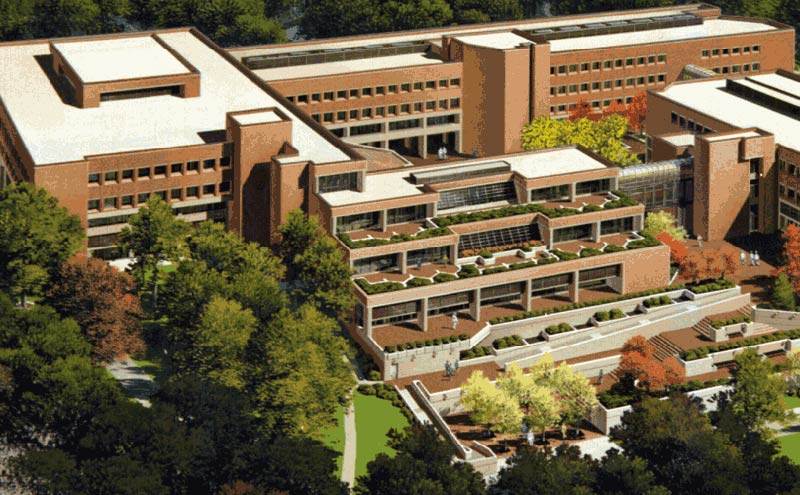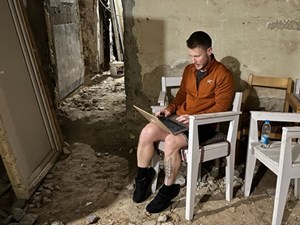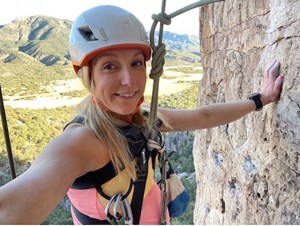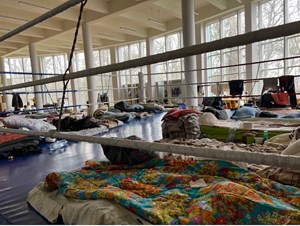
Wilderness Medicine in Military Medical Curriculum
USU SoM is the country’s only medical school dedicated to educating active duty military officers to become physicians. This SoM has a unique mission, which calls for unique education. Wilderness medicine has been interwoven into the curriculum due to its synergies with military medicine [1, 2]. Our Armed Forces have faced heat and exertional injuries in the Middle East, cold weather, and altitude-related challenges in areas of Afghanistan where the Hindu Kush mountains are nearly 7,500m high [3]. Many medical providers in the military have previously acquired their training through operational necessity, but wilderness medicine has become increasingly available to medical students.
The SoM has specifically defined periods of didactics, team-training evolutions, and hands-on field practicums spread throughout the four years of medical school. Topics span from acute mountain sickness and tropical infections to hyperbaric dive medicine. This curriculum is taught as part of a series of Medical Field Practicum (MFP) courses. Additionally, students receive certifications in advanced life support and advanced trauma life support through undergraduate medical training. Lastly, students attend a mandatory course called Combat Medical Skills, which teaches the basics of Tactical Combat Casualty Care (TCCC). The following courses are part of the required core modules:
MFP 101- Introduction to Operational Military Medicine
An introduction to wilderness medicine, with an emphasis on military relevant medicine, begins during the first year. Students spend five days in the field, learning the basic competencies of field medicine. In addition to tactical movement, land navigation, weapons familiarization, and hand-to-hand combatives; topics that relate to wilderness medicine include environmental medicine, preventive medicine in an austere setting, tropical diseases, and trauma evaluation, and casualty evacuation.
MFP 102 – Advanced Combat Medical Experience (2nd year of medical school)
ACME is a one-week course focused on developing and reinforcing knowledge, skills, and attitudes necessary to perform effective field assessment and stabilization of combat-wounded casualties. Students learn to identify and treat most common causes of preventable death on the battlefield. Students also learn about crisis communication best practices, team communication, and operational logistics.
MFP 201 – Operation Gunpowder (3rd year of medical school)
MFP201 is a one-day evaluation after a week-long preparation course focused on prolonged field care (PFC), walking blood bank, critical care of patients in austere setting, casualty evacuation, and flight critical care.
MFP 202 – Operation Bushmaster (4th year of medical school)
Operation Bushmaster is five-day field event following a two-week preparation course. It is essentially the final assessment of the entire SoM’s military-unique curriculum. Students are expected to be proficient in casualty prevention, preventive medicine, health surveillance, risk management, combat and operational stress control, Tactical Combat Casualty Care (TCCC), Prolonged Field Care (PFC), forward resuscitative care, medical logistics, medical operational planning, medical evacuation, and military medicine operational doctrine and planning across a wide range of military operations[4]. Much of the military’s operational doctrine and logistics can perhaps translate well to expeditionary wilderness medicine.
Electives
In addition to the required didactic and practical series above, the SoM also has a vast list of elective wilderness medicine experiences that students can attend if interested. This includes the Marine Corps’ Mountain Medicine Course, the Army’s Mountain Medicine/Cold Weather Medicine/Avalanche Survival Course, flight medicine, dive medicine, Special Operations Combat Medic Course, and tropical medicine. Students also attend professional conferences, and are actively engaged in the Wilderness Medical Society (WMS) where people like Dr. Paul Auerbach, past President and founder of the WMS, are strong supporters of military medicine.
Ivan’s Experience
Growing up in the suburbs of Orange County, California, my limited exposure to the wilderness in my childhood began with family camping and beach trips. As I entered my pre-teens, I joined the Boy Scouts and was inundated with outdoor experiences, including wilderness survival classes, camping on Catalina Island, and backpacking over 80 miles in New Mexico. I received my open water scuba certification in high school and led backpacking trips for my less experienced peers. I studied environmental systems in college, wanting to learn more about our wilderness.
After college, prior to starting medical school, I enlisted in the United States Navy as a Navy Corpsman and was expected to both master and teach Tactical Combat Casualty Care to my Marines. The Marines seemed to really love camping outside all the time as well. I attended the Mountain Medicine Course at the Marine Corps’ Mountain Warfare Training Center and was certified as a Military Wilderness First Responder. My time at the Uniformed Services University (USU) has only further reinforced my passion for wilderness medicine.
Cat’s experience
Unlike Ivan, I didn’t serve in the military prior to coming to USU. My interest in wilderness medicine was a blend of my love of being outdoors and desire to help my community. As a young girl I spent time on my grandparent’s farm and playing in the forest behind my house. I spent a lot of time in the woods and exploring the wilderness. When I was older, I used endurance sports, including running, biking, and triathlons, as a way to enjoy a refreshing break from a hectic world within a concrete jungle. Throughout undergraduate, graduate, and medical school, I used endurance sports as my refuge to gather my thoughts, reflect, and quell my restless energy from the day. I joined the military just before I entered medical school, so that I could take care of the men and women that fought for our country. Little did I know at that time that I would be able to combine my career aspirations with my love of the outdoors. Military medicine has provided the perfect template for my career.
Conclusion
Both Ivan and I plan on working towards the Wilderness Medical Society’s Diploma in Mountain Medicine (DiMM) and the Fellowship in the Academy of Wilderness Medicine (FAWM) certificates. USU’s unique education feeds our passion for wilderness medicine and prepares us to care for our active-duty war fighters in austere environments [5]. While deployed, military physicians provide guidance to their commanders in order to complete the military mission successfully and safely. Our skills will also help improve civilian efforts in preventative medicine, global medicine initiatives, humanitarian assistance, and disaster response [6]. Many similar themes and topics are discussed at civilian wilderness medicine gatherings and civilian leaders in wilderness medicine often have military backgrounds [7]. The inclusion of wilderness medicine in our curriculum has helped us to become well-rounded physicians armed with the flexibility and adaptability to overcome difficult and unforeseen circumstances. We hope to continue to build on the collaborative nature of wilderness medicine that has blended military and civilian medical training and knowledge into a robust area of medicine.
Acknowledgements
We would like to thank our current Dean, Dr. Arthur Kellerman, and Major General (ret.) Richard W. Thomas, President of USU, for being supportive in getting students involved in operational medicine and wilderness medicine. Additionally, faculty members, like COL Ian Wedmore and LTC (ret.) Matt Welder have made wilderness medicine courses available to us. We would also like to thank Col John Wightman, Chair of the Department of Military and Emergency Medicine, and the Graduate Programs in Health Professions Education, USU, Bethesda, Maryland for review of this article.
References
- Butler FK, Bennett B, Wedmore CI. Tactical Combat Casualty Care and Wilderness Medicine: Advancing Trauma Care in Austere Environments. Emerg Med Clin North Am. 2017 May;35(2):391-407. doi: 10.1016/j.emc.2016.12.005. Review. PubMed PMID: 28411934.
- Zafren, Ken; Butler, Frank K. Wilderness medicine and military medicine. Wilderness & Environmental Medicine, 06/1998, Volume 9, Issue 2
- Gellasch CA, Calix LC. Preventive medicine support in Afghanistan during Operation Enduring Freedom VI. U.S. Army Medical Department journal. 2007:56-64.
- Goolsby, C; Deering, S. Hybrid Simulation During Military Medical Student Field Training-A Novel Curriculum. MILITARY MEDICINE, 07/2013, Volume 178, Issue 7
- Bennett, Brad L; Butler, Frank K.; Wedmore, Ian S: Tactical Combat Casualty Care: Transitioning Battlefield Lessons Learned to Other Austere Environments. Wilderness & Environmental Medicine, 2017, Volume 28, Issue 2.
- Strauss-Riggs, K; Yeskey, K; Miller, A; Arnesen, S; Goolsby, C. Translating Battlefield Practices to Disaster Health. DISASTER MEDICINE AND PUBLIC HEALTH PREPAREDNESS, September 2017(Vol 11 Issue 4)
- Givens, Melissa; Muck, Andrew E; Goolsby, Craig. Battlefield to bedside: Translating wartime innovations to civilian Emergency Medicine American Journal of Emergency Medicine, 11/2017, Volume 35, Issue 11
Catherine Woodard and Ivan Yue
Uniformed Services University (USU) F. Edward Herbert School of Medicine (SoM)



